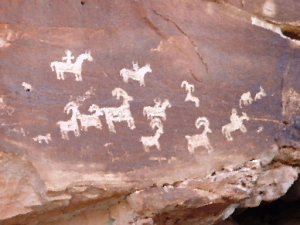Proto-Western
| Proto-Western | |
| Period | c. -3500 YP |
| Spoken in | West Coast |
| Total speakers | unknown |
| Writing system | none |
| Classification | Western languages Proto-Western |
| Typology | |
| Basic word order | SOV |
| Morphology | agglutinating w/ some fusion |
| Alignment | ERG-ABS |
| Credits | |
| Created by | Dewrad |
Proto-Western is the reconstructed ancestor of the Western languages, a family spoken for the most part in the western areas of Peilaš (hence the designation). It is estimated to have been spoken around -3500 YP.
Features
Proto-Western is reconstructed with 28 consonants (*p t c č k kʷ ʔ pʰ tʰ cʰ čʰ kʰ kʷʰ b d dz dž s š γ γʷ l ł m n ñ y w), four oral vowels (*i e a u) and four nasalised vowels (*ĩ ẽ ã ũ).
The most distinctive class of morphemes in Proto-Western was a set of classifiers, which formed a core element of the language's morphosyntax. These classifiers could function e.g. as verbal argument markers, "phoric" pronouns, obligatory classifiers on determiners, and bases for pronouns, to list but the most important uses.
Proto-Western nominals inflected for case, number, possessor, and for edibility of their referent. Lacking a separate class of adjectives, derivational morphemes were used to refine and extend the meanings of nouns in a similar way to adjectives in orther languages. Verbs inflected for both the agentive and patientive arguments of the action, and for evidentiality (with a total of eight reconstructible markers). Patientive arguments (in monotransitive sentences) or Themes (in ditransitive sentences) could be incorporated into the verb, reducing the valency by one. Word order was usually SOV, with several transformations available, e.g. topic fronting.
Descendants
Proto-Western is the ancestor of a large language family, which dominates most of the western regions of Peilaš. While most of its descendants remain in the Great Western Plain, one branch has migrated eastwards into the Edastean sphere, giving rise to two languages there, Gezoro and Tjakori.
The major divisions of the Western linguistic stock are the Coastal family of the southern west coast of Peilaš; the Steppe family that dominates the Plain; the Wañelin family based around the large Wañelin lake; and the Plateau family (to which Gezoro belongs). Together these four branches account for around two thirds of all Western languages. There are also few Western isolates not belonging to any of the four main branches; all of the above are believed to have diverged in the prehistoric Western Diaspora.
- Proto-Western (Peilaš west coast, c. -3500 YP - Dewrad)
- Coastal languages
- Proto-Coastal-Western (Lukpanic coast, c. -1800 YP - Legion, TzirTzi)
- Ìletlégbàku (Nugbùn, c. -900 YP - Alces)
- Doayâu (Pítau, c. -500 YP - Cedh)
- Ishoʻu ʻOhu (Ishe, c. -450 YP - thedukeofnuke)
- U Bol (Doanu, c. -200 YP - CatDoom)
- Proto-Coastal-Western (Lukpanic coast, c. -1800 YP - Legion, TzirTzi)
- Steppe languages
- Iŋomœ́ (West Peilaš steppe, c. -2000 YP - eodrakken)
- Satnímʔa (West Peilaš steppe, c. -1000 YP - Kohorik)
- ʔuulhemoo (Peilaš northwest coast, c. 100 YP - CatDoom)
- Hanheliubl (West Peilaš steppe, c. -1000 YP - Nortaneous)
- Satnímʔa (West Peilaš steppe, c. -1000 YP - Kohorik)
- Iŋomœ́ (West Peilaš steppe, c. -2000 YP - eodrakken)
- Lake languages (Wañelin languages)
- Çetázó (Wañelin, c. -2000 YP - WeepingElf)
- Plateau languages (Gezoro languages)
- Valley languages
- Desert languages
- Mountain languages
- Mountain Western (Western mountains, c. -1800 YP - Radius)
- Coastal languages
Sample
- Γʷeyeʔu tabe łãšiʔi mẽγuk čeldawata. ʔašẽʔi takʷaduʔu mẽγuʔu tʰula besawakʰiw, kʷelaʔi šiduʔu mẽγuγ γlaʔtawata, laʔi nałtuduʔu mẽγuγ wadžedzakata. Yawaʔu kʰayaʔu nat mẽcaduʔu mẽγuγ kʷekʷuta.
- [ ˌɣʷɛ.jɛ.ʔu ˌta.bɛ ˈɬã.ʃi.ʔi ˌmɛ̃.ɣuk ˈʧɛl.da.wa.ta ‖ ˌʔa.ʃɛ̃.ʔi ˈta.kʷa.du.ʔu ˌmɛ̃.ɣu.ʔu ˌtʰu.la ˈbɛ.sa.wa.kʰiw | ˌkʷɛ.la.ʔi ˈʃi.du.ʔu ˌmɛ̃.ɣuɣ ˈɣɫaʔ.ta.wa.ta | ˌla.ʔi ˈnaɬ.tu.du.ʔu ˌmɛ̃.ɣuɣ ˈwa.ʤɛ.ʣa.ka.ta ‖ ˌja.wa.ʔu ˈkʰa.ja.ʔu ˌnat | ˈmɛ̃.ʦa.du.ʔu ˌmɛ̃.ɣuɣ ˈkʷe.kʷu.ta ]
- hill-CONS on horse-ERG sheep-PL.ABS see-3.ABS.{I}-3.ABS.{III}. woman-ERG first-CONS sheep-CONS wool-ABS cut-3.ABS.{I}-3.ABS.{VII}, child-ERG second-CONS sheep-ABS.{edible} milk-3.ABS.{I}-3.ABS.{III}, man-ERG third-CONS sheep-ABS.{edible} kill-3.ERG-3.ABS.{III}. ANAPHOR-{human}-CONS fire-CONS above fourth-CONS sheep-ABS.{edible} cook-3.ABS.{III}
(taken from The horse and the sheep)
See also
- Proto-Western grammar (original URL: [1])
- Proto-Western lexicon (original URL: [2])
- The culture of Proto-Western speakers (original URL: [3])
